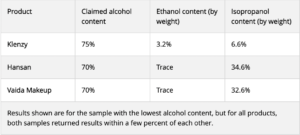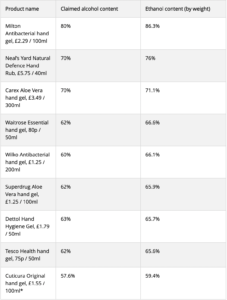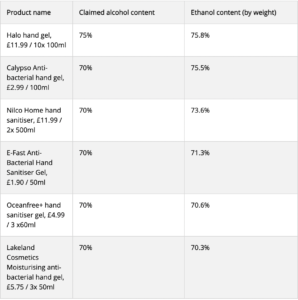
By Hannah Fox, which.co.uk
4th December 2020
Independent Which? tests have revealed that some alcohol-based hand sanitisers contain a fraction of the alcohol content they claim to, leaving those who buy them unknowingly unprotected from coronavirus – and other bacteria and viruses these products are supposed to kill.
Alcohol-based hand sanitiser with an alcohol content of at least 60% is recommended by the World Health Organisation (WHO) and other experts as the best way to kill any COVID-19 virus particles that may be on your hands when out and about (thorough hand washing with soap is preferable, but not always practical). We tested 18 alcohol-based hand sanitisers, including branded and own-brand options from major retailers, supermarkets and online marketplaces.
Three hand sanitiser products, contained far less alcohol than claimed, and too little to be effective at killing germs.
So, if you’re stocking up on sanitiser, make sure you check our list of the products that passed, below, to ensure you get one that contains enough alcohol to do the job properly. Hand hygiene explained – we delve into the science behind soap and sanitiser, to help you choose the best options Best face coverings – our independent tests reveal the best face masks for filtration and breathability
Hand sanitisers to avoid:
Three hand sanitisers did not contain the percentage of alcohol that was claimed on either the packaging or the product listing page.
These products don’t contain enough alcohol to kill germs effectively, and should be avoided:
- Hansan Antibacterial Hand Sanitiser (bought from eBay)
- Klenzy Hand Sanitizing Gel (bought from eBay)
- Vaida Makeup ‘Dream Big’ Hand Sanitiser Gel (bought from Etsy)
When the first sample failed our tests, we tested a second sample of each product to check if it was a one-off. But the results for both samples, bought at random, were nearly identical. The Klenzy hand sanitiser had just 10% alcohol content in total, while the Hansan and Vaida Makeup products had just over 30%. All claimed to contain at least 70% alcohol.
We tested hand sanitiser alcohol content by weight. Manufacturers differ in how they quote alcohol content, using either weight or volume, and many don’t specify what the claim is based on. By volume, the percentage alcohol content figures for these products would be slightly higher, but would still fall well short of recommended levels – and the claim on the bottle.
Hand gels removed from sale following Which? tests
We contacted the individual sellers and relevant online marketplaces with our findings. We did not receive a response from the sellers of the Hansan and Klenzy gels and were unable to find the contact details for the manufacturers of these products. eBay told us it had removed both the product listings and that the sellers would no longer be permitted to sell hand sanitiser on its website.
The Etsy seller of the Vaida Makeup hand sanitiser told us that it had removed the listing and contacted all customers to warn them of the lower alcohol content in the sanitiser and to offer a full refund. Etsy told us it was ‘pleased’ the seller had removed the item from sale, stating: ‘We don’t have final control over sellers’ items but do ask they act with integrity, as was the case here by them taking action once the issue was brought to their attention.’ We shared our findings with the Office for Product Safety and Standards (OPSS) for further investigation. It told us it has passed them on to the Health and Safety Executive and Trading Standards.
Which hand sanitisers passed the alcohol test?
The good news is that the remaining 15 hand sanitisers we tested all had the percentage levels of alcohol that they claimed or higher, and at a level that would be effective against bacteria and viruses. Some of these products may have been hard to get hold of in the early days of the pandemic, but supplies have since stabilised.
*The Cuticura product states it has 57.6% ethanol by weight, which converts to 66% ethanol by volume and so meets the 60% minimum requirement.
Online hand sanitiser results The selection of products we tested all contained the alcohol they claimed to:
These products tended to have a slightly higher alcohol content than high street gels, though bear in mind if you have sensitive hands, they may tolerate a lower effective alcohol concentration better. Note: some of the samples in the tables above also contain small amounts of isopropanol, but the main active ingredient is ethanol.
Why is alcohol important in hand sanitiser?
The alcohol found in hand sanitisers is usually ethanol, isopropanol or a mixture of the two. Alcohol destroys viruses and bacteria by dissolving the outer layer which inactivates them. This is how it kills the COVID-19 virus. Ethanol is what you get in drinking alcohol, while isopropanol is what’s more commonly known as ‘rubbing alcohol’.
At the right percentage (at least 60% by volume, according to the WHO) both will have the same sanitising effect on bacteria and viruses. However, if the hand sanitiser doesn’t contain a high enough percentage of alcohol, then it won’t be able to kill off the bacteria and viruses on your hands effectively.
Methanol in hand sanitiser Hand sanitiser has been in high demand this year, and at times very hard to find. But it pays to be cautious about who and where you buy from. In the US, the FDA has warned about a long list of hand sanitiser brands that were found to contain methanol, which is highly toxic, while in Australia, consumer organisation Choice has also uncovered hand sanitisers with a fraction of the claimed alcohol content. We didn’t detect methanol in any of the hand sanitiser samples we tested. However, we tested only a few of the many brands available online, and it pays to remain vigilant, as there have been some hand gel products recalled in the UK which were found to contain methanol. Symptoms of methanol poisoning include headaches, blurred vision, nausea and vomiting, loss of coordination and decreased levels of consciousness.
What about non-alcoholic hand sanitiser?
Alcohol-based hand sanitisers can be irritating and drying for the skin, especially when used more frequently. There are alcohol-free alternatives, which are gentler on the hands, but knowing which ones work effectively is no simple task. Alcohol-based sanitisers are recommended for protection against COVID-19 in public health messaging because the evidence for them working at the right concentration is quite clear-cut.
Some common chemicals used in non-alcoholic hand sanitisers have been proven to be effective on surfaces and in suspension tests (in lab conditions), but the evidence isn’t as clear for use on hands. EN1500 is the standard that products must pass to demonstrate bactericidal efficacy when the product is applied to hands, but there isn’t a test standard like this for enveloped viruses on hands.
Ecohydra, one of the main alcohol-free hand sanitiser manufacturers, is calling for clarity on the matter and for a kitemark standard for non-alcoholic hand sanitisers to be introduced so that consumers can easily see which products have passed tests. For more advice on sanitisers and soaps, head to our full hand hygiene guide.
Are you using your hand sanitiser properly? As well as buying a hand sanitiser you can trust, it’s also important that you store and use your hand sanitiser the right way in order for it to work. Check out our video guide below to get our top tips on using hand sanitiser effectively to kill germs.
- Sanitise after touching any surfaces or items that could be contaminated, such as hand rails, doors or your face mask.
- Reapply if you touch anything after this.
- Use enough hand sanitiser to cover the full surface area of your hands, not forgetting your wrists and nails.
- Rub it in for at least 20 to 30 seconds or, most importantly, until your hands are dry.
- Store away from direct heat and light sources, and don’t leave it open – as this could impact the quality and efficacy of the product.
Reference: Hand Sanitisers Sold Online Fail Which Tests – Which?
View our range of licensed hand sanitisers and gels







